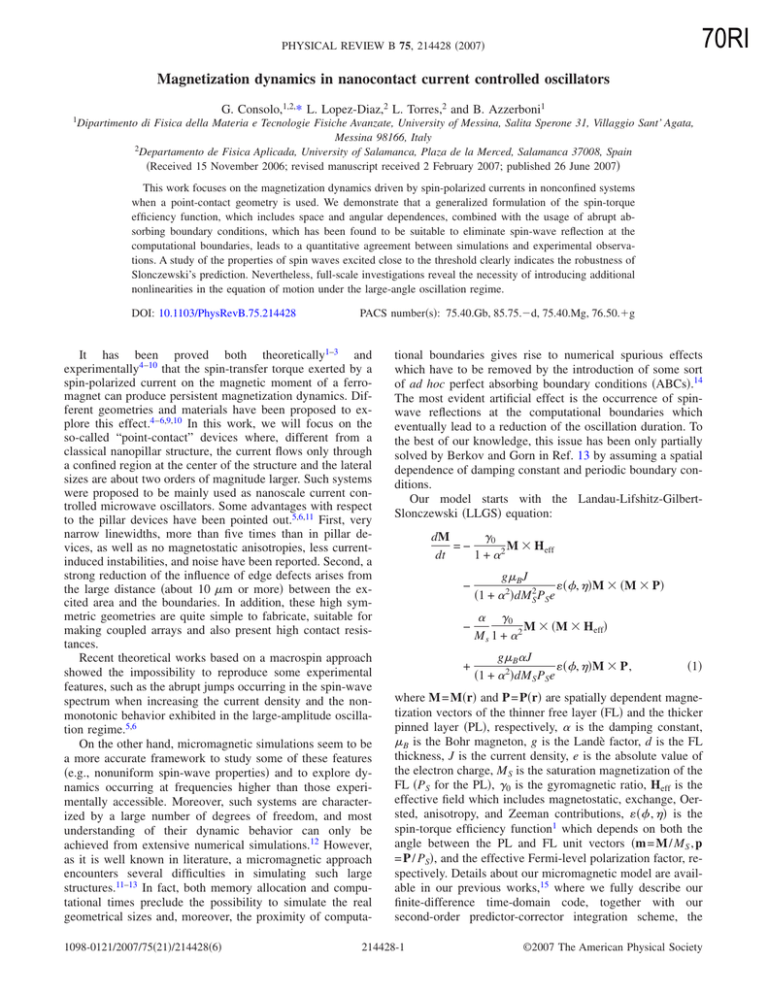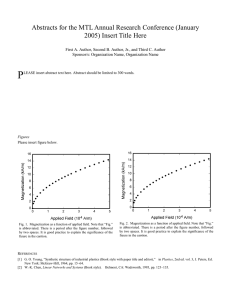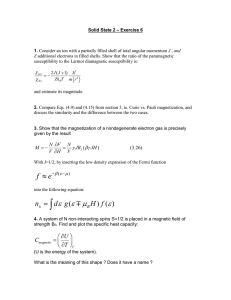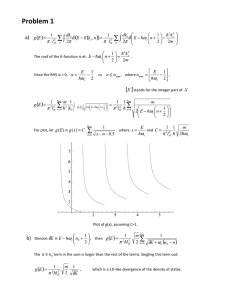Magnetization dynamics in nanocontact current controlled oscillators
advertisement

70RI PHYSICAL REVIEW B 75, 214428 共2007兲 Magnetization dynamics in nanocontact current controlled oscillators G. Consolo,1,2,* L. Lopez-Diaz,2 L. Torres,2 and B. Azzerboni1 1Dipartimento di Fisica della Materia e Tecnologie Fisiche Avanzate, University of Messina, Salita Sperone 31, Villaggio Sant’ Agata, Messina 98166, Italy 2 Departamento de Fisica Aplicada, University of Salamanca, Plaza de la Merced, Salamanca 37008, Spain 共Received 15 November 2006; revised manuscript received 2 February 2007; published 26 June 2007兲 This work focuses on the magnetization dynamics driven by spin-polarized currents in nonconfined systems when a point-contact geometry is used. We demonstrate that a generalized formulation of the spin-torque efficiency function, which includes space and angular dependences, combined with the usage of abrupt absorbing boundary conditions, which has been found to be suitable to eliminate spin-wave reflection at the computational boundaries, leads to a quantitative agreement between simulations and experimental observations. A study of the properties of spin waves excited close to the threshold clearly indicates the robustness of Slonczewski’s prediction. Nevertheless, full-scale investigations reveal the necessity of introducing additional nonlinearities in the equation of motion under the large-angle oscillation regime. DOI: 10.1103/PhysRevB.75.214428 PACS number共s兲: 75.40.Gb, 85.75.⫺d, 75.40.Mg, 76.50.⫹g It has been proved both theoretically1–3 and experimentally4–10 that the spin-transfer torque exerted by a spin-polarized current on the magnetic moment of a ferromagnet can produce persistent magnetization dynamics. Different geometries and materials have been proposed to explore this effect.4–6,9,10 In this work, we will focus on the so-called “point-contact” devices where, different from a classical nanopillar structure, the current flows only through a confined region at the center of the structure and the lateral sizes are about two orders of magnitude larger. Such systems were proposed to be mainly used as nanoscale current controlled microwave oscillators. Some advantages with respect to the pillar devices have been pointed out.5,6,11 First, very narrow linewidths, more than five times than in pillar devices, as well as no magnetostatic anisotropies, less currentinduced instabilities, and noise have been reported. Second, a strong reduction of the influence of edge defects arises from the large distance 共about 10 m or more兲 between the excited area and the boundaries. In addition, these high symmetric geometries are quite simple to fabricate, suitable for making coupled arrays and also present high contact resistances. Recent theoretical works based on a macrospin approach showed the impossibility to reproduce some experimental features, such as the abrupt jumps occurring in the spin-wave spectrum when increasing the current density and the nonmonotonic behavior exhibited in the large-amplitude oscillation regime.5,6 On the other hand, micromagnetic simulations seem to be a more accurate framework to study some of these features 共e.g., nonuniform spin-wave properties兲 and to explore dynamics occurring at frequencies higher than those experimentally accessible. Moreover, such systems are characterized by a large number of degrees of freedom, and most understanding of their dynamic behavior can only be achieved from extensive numerical simulations.12 However, as it is well known in literature, a micromagnetic approach encounters several difficulties in simulating such large structures.11–13 In fact, both memory allocation and computational times preclude the possibility to simulate the real geometrical sizes and, moreover, the proximity of computa1098-0121/2007/75共21兲/214428共6兲 tional boundaries gives rise to numerical spurious effects which have to be removed by the introduction of some sort of ad hoc perfect absorbing boundary conditions 共ABCs兲.14 The most evident artificial effect is the occurrence of spinwave reflections at the computational boundaries which eventually lead to a reduction of the oscillation duration. To the best of our knowledge, this issue has been only partially solved by Berkov and Gorn in Ref. 13 by assuming a spatial dependence of damping constant and periodic boundary conditions. Our model starts with the Landau-Lifshitz-GilbertSlonczewski 共LLGS兲 equation: ␥0 dM =− M ⫻ Heff dt 1 + ␣2 − g BJ 共, 兲M ⫻ 共M ⫻ P兲 共1 + ␣2兲dM 2S PSe − ␣ ␥0 M ⫻ 共M ⫻ Heff兲 M s 1 + ␣2 + g B␣ J 共, 兲M ⫻ P, 共1 + ␣2兲dM S PSe 共1兲 where M = M共r兲 and P = P共r兲 are spatially dependent magnetization vectors of the thinner free layer 共FL兲 and the thicker pinned layer 共PL兲, respectively, ␣ is the damping constant, B is the Bohr magneton, g is the Landè factor, d is the FL thickness, J is the current density, e is the absolute value of the electron charge, M S is the saturation magnetization of the FL 共PS for the PL兲, ␥0 is the gyromagnetic ratio, Heff is the effective field which includes magnetostatic, exchange, Oersted, anisotropy, and Zeeman contributions, 共 , 兲 is the spin-torque efficiency function1 which depends on both the angle between the PL and FL unit vectors 共m = M / M S , p = P / PS兲, and the effective Fermi-level polarization factor, respectively. Details about our micromagnetic model are available in our previous works,15 where we fully describe our finite-difference time-domain code, together with our second-order predictor-corrector integration scheme, the 214428-1 ©2007 The American Physical Society 70RI PHYSICAL REVIEW B 75, 214428 共2007兲 CONSOLO et al. FIG. 1. 共Color online兲 Point-contact geometry, materials, and sizes. implementation of the six-neighbor exchange interaction, and all the other contributions to the effective field. In order to enable a comparison with experimental spectra, we have chosen the parameter values as close as possible to the experimental ones presented by Rippard et al. in Ref. 5. In particular, the spin-valve structure under investigation is composed by a trilayer Co90Fe10 共20 nm兲 / Cu 共5 nm兲 / Ni80Fe20 共5 nm兲, whose lateral dimensions, for the computational limitations cited above, have been set as 600 ⫻ 600 nm2, whereas the real dimensions were 8 ⫻ 12 m2. The point-contact area is assumed to be circular in shape with a radius R = 20 nm 共see Fig. 1兲. According to Refs. 1 and 11 value = 0.4 has been considered for the Co90Fe10. Other parameters are exchange constant A = 1.3⫻ 10−11 J / m, g = 2.0, ␣ = 0.015, M S = 500⫻ 103 A / m, and no crystalline anisotropy for the FL, while PS = 1.5⫻ 106 A / m and a cubic anisotropy constant kani = 5.6⫻ 104 J / m3 for the PL. The computational region is discretized in a two-dimensional mesh of 4 ⫻ 4 ⫻ 5 nm3 prismatic cells in order to integrate the LLGS equation 关Eq. 共1兲兴 numerically. Calculations performed with a grid size of 2.5⫻ 2.5⫻ 5 nm3 do not produce quantitative changes with respect to both wavelength and frequency of the main excited mode. In this work, our first goal is to investigate the dynamics occurring under an applied field Hext = 0.9 T perpendicular to the device plane. Since the experimental alignment to the z axis is nominal only,16 we have implemented an external field which forms an out-of-plane angle of  = 87°. As inferred by Rippard et al. in Ref. 5, it has been numerically checked that this field tilts the magnetization of the PL about 30° out of the film plane. Due to large thickness and saturation magnetization, we neglect the current-induced dynamics occurring in the PL, whose magnetization has been consequently considered as spatially uniform and time independent. The magnetostatic field created by the PL in the FL is considered to be spatially uniform and due to the out-ofplane component of the magnetization only.17 A stochastic contribution arising from the thermal noise should be included in the effective field computation because the measurements reported in Ref. 5 were performed at room temperature. Results of our calculations show that these random fluctuations do not affect the frequency of the excited spin waves 共the spectra obtained in the T = 0 K and T = 300 K models differ for less than 1%兲, so that we have considered the deterministic case T = 0 K in our approach 共we are neglecting the thermal effect on linewidths, whose analysis is beyond the scope of the present work兲. Another issue involves the choice of the boundary conditions for the exchange field. In our view, the “periodic” boundary conditions 共PBCs兲 used in Ref. 13 do not represent a reasonable solution for three main reasons. First, PBCs do not correspond to a physical or geometrical property of the structure under investigation. Second, the neighbor periodic images generate further waves traveling inward which definitely interfere with the ones traveling outward. Third, in an implicit manner, the implementation of PBC is equivalent to the simulation of a point-contact matrix, whose additional self-phase locking9,10 could represent a non-negligible noisy term. In our approach, normal boundary conditions have been implemented in the usual manner: 冏 冏 m n = 0, 共2兲 boundaries where n is the direction normal to the boundaries. Our micromagnetic model will be completely specified once we address three important issues: the current-density distribution, the spin-torque efficiency function, and the ABC implementation. Let us first examine some details about their formulation and influence on the magnetization dynamics. The current-density function 关J共r兲, r is the distance from the center兴 describes the spatial distribution of electrons over the FL. Since no information is available about it, the current-density profile inside the contact area is generally considered to be uniform 关J共r 艋 R兲 = J0兴, whereas one could assume either an abrupt cutoff 关J共r ⬎ R兲 = 0兴 or, most likely, a smooth Gaussian-type distribution 共J共r ⬎ R兲 = J0 exp关−共r − R兲2 / 22兴, is the smoothing parameter兲 in the external region.13 The spin-torque efficiency function derived by Slonczewski1 for a macrospin model can be stated as follows: 共, 兲 = cf共, 兲 = c关− 4 + 共1 + 兲3共3 + cos 兲/43/2兴−1 , 共3兲 where we have simply multiplied the original formulation f共 , 兲 by a constant c. To generalize expression 共3兲 within a micromagnetic framework, one could assume a constant-intime and uniform-in-space value 关共 , 兲 = c , f共 , 兲 = 1兴 or, alternatively, allow for a time and spatial variation 共the time dependence indirectly arises from the time evolution of the angle between FL and PL兲.18 In both cases, different spintransport mechanisms 共ballistic or diffusive兲 could be included in our framework. In the former, this distinction is simply made by choosing a proper value for the c parameter,2 whereas, in the latter, it is possible to include those mechanisms in the function f共 , 兲. In detail, the deterministic trajectory associated with a ballistic transport is 214428-2 70RI PHYSICAL REVIEW B 75, 214428 共2007兲 MAGNETIZATION DYNAMICS IN NANOCONTACT CURRENT… taken into account by considering 共 , 兲 = f共 , 兲 with a local angular dependence between PL and FL 关cos 共r兲 = m共r兲 · p共r兲兴, while the nonlocal diffusive transport behavior is included by averaging the previous efficiency values over the contact area 共 , 兲 = 具f共 , 兲典 共c = 1 in both cases兲. The effects of the spatial distribution of both the current density and the spin-torque efficiency function have been extensively treated elsewhere.19 The ABCs introduced by Berkov and Gorn in Ref. 13 were based on three main assumptions: 共i兲 the dissipation within and nearby the contact area must be equal to its physical value, 共ii兲 dissipation far from the contact area and close to the simulated boundaries must be large enough to ensure the wave energy absorption, and 共iii兲 the spatial variation between these two values must be smooth enough to prevent wave reflection at the boundary. Even though this formulation assures a stable magnetization precession, it presents the strong drawback of an additional reduction of the computational area having physical properties 共it is not consequently suitable, for example, for the modeling of multiple contact geometries without a further increase of the computational area兲. Leaving the first two assumptions of Berkov and Gorn unchanged, we based our proposal on the following further requirements: 共i兲 to create a nonphysical absorbing medium surrounding the computational area, 共ii兲 to consider a damping coefficient two orders greater than the physical one 共which corresponds to a damping value of the order of unity兲 just in the boundary cells, and 共iii兲 the computational area must entirely preserve its physical properties 共see Ref. 20兲. Our study shows that the unphysical damping value at the edges must be properly set 共e.g., according to the size of the computational area兲. In addition, an abrupt transition of damping of more than two orders of magnitude could generate itself further reflections because of a significant change of the media properties, in agreement with the third assumption of Berkov and Gorn. Due to the difficulties of this nontrivial issue, we have first carried out some preliminary numerical investigations to check the validity of the proposed approach. To this aim, by keeping the grid size fixed and starting from a structure of 1 m side, we progressively reduced the size of the computational region until variations greater than 3% 共in both frequency, wavelength, magnetization trajectory, and mode structure of the excited spin waves兲 were observed. For the geometry under investigation, results show that the smallest computational area which satisfies the previous criteria is of 600 nm. We would like to point out that because we do not get any substantial changes when the computational domain is shrunk from 1 m to 600 nm, we believe that the behavior for larger computational domains 共which would require unaffordable computational times and memory allocation兲 does not differ from that observed in the considered range if proper ABC are taken into account. We also stress that the largest considered domain 共1 ⫻ 1 m2兲 is still much smaller than the physical domain 共12⫻ 8 m2兲, but it is, however, of the same order of magnitude as the one considered by other authors for the same geometry.11,13 In Fig. 2, we summarize some representative results, in space, time, and frequency domains, obtained with and with- FIG. 2. 共Color online兲 共a兲 Snapshot of the spatial configuration of the spins at t = 10 ns, 共b兲 time evolution of the normalized x 共red兲 and z 共black兲 contact-averaged magnetization components, and 共c兲 the corresponding spin-wave spectra computed for I = 8 mA, 共 , 兲 = 0.19, Hext = 900 mT out of plane, with no ABC in the micromagnetic framework. 关共d兲–共f兲兴 Same as in 共a兲–共c兲 but with the proposed abrupt ABC. out including the proposed ABC in the micromagnetic framework. Each of them proves that the abrupt profile for the ABC both guarantees the expected magnetization trajectories without generating any interference phenomenon 共even though the robustness of the proposed approaches has been tested over a temporal window of 30 ns, the graphs are representative of the first 10 ns only to improve the readability兲 and gives rise to a noise-free spin-wave spectrum. In order to directly compare our results with the experimental spectrum given in Fig. 4共b兲 of Ref. 5, we consider first a naïve setup consisting of abrupt cutoff of the current density outside the contact area, a time-independent and spatially uniform efficiency value, and the proposed ABC. Results are shown in Fig. 3. It is worth noticing how the spectrum close to the threshold value could be reproduced by using an efficiency value 共 , 兲 = c = 0.19, while the range between 4.5 and 7.5 mA could be only qualitatively described using a higher efficiency 共 , 兲 = c = 0.28. It should be remarked the actual impossibility to reproduce the dynamics occurring for higher currents as well as the abrupt jumps observed at 4.5 and 6 mA 共similar results were obtained by Hoefer et al. in Ref. 21, where the difficulty in reproducing most of the physical relationships was solved by using different efficiency values兲. To make this point clear, we have performed an investigation with the aim of looking for those efficiency values 214428-3 70RI PHYSICAL REVIEW B 75, 214428 共2007兲 CONSOLO et al. FIG. 3. 共Color online兲 Comparison between the experimental and computed spin-wave spectra using the naïve setup for two different transport mechanisms 共ballistic c = 0.19 and diffusive c = 0.28兲. necessary to fit the experimental spectrum. Results of such investigation 共not shown兲 represent the efficiency function as a multibranch arbitrarily function of current 关i = ci共J兲兴. This behavior does not find any physical explanation. In addition, as briefly introduced above, the excited frequencies exhibit another singular behavior for I ⬎ 10 mA, where the initial monotonic blueshift trend 共frequency increases with increasing current兲 saturates and, finally, moves toward a redshift. On a qualitative level, a similar behavior was already obtained in Ref. 21 共see Fig. 3 of Ref. 21兲. Observing the spatial spin configuration, we are able to find out the source of this anomaly. In those cases, the z component of the contactaveraged magnetization is orientated along the −z direction, opposite to the rest of the spins outside the contact, and the whole system precesses around this 180° domain-wall configuration. Consequently, the rate of precession is reduced and the magnetization trajectories become distorted from the circular 共low-current兲 case. Even if we take into account a smooth current-density distribution profile 共the parameter is chosen in such a way the current flow covers a disk of radius RI = 1.4R兲, just the slope of the curve is slightly raised but we do not substantially get different behaviors. In all cases, however, the observed redshift trend is more emphasized in our calculations than in the real case. Based on these results, we conclude that some initial assumptions must be released. We believe that the source of the discrepancy is mostly related to the formulation of the spintorque efficiency function as a constant value 共 = c兲. In fact, the constant efficiency term derived by Slonczewski in 1999 within the ballistic free-electron model 关see Eq. 共2兲 of Ref. 2兴 holds under the strong hypothesis that M and P stay almost aligned during the precession 共small-angle oscillation regime兲 and oriented along the z axis. The same result could be obtained from the original formulation made in 1996 关see Eq. 共14兲 of Ref. 1兴 by assuming cos = m · p ⬇ 1. Since this approximation in not strictly valid in the observed dynamics, we reintroduce the angular dependence 共兲 of the spintorque efficiency function in our model. Using the proposed ABC, we take into account both the efficiency formulations 关共 , 兲 = f共 , 兲 and 共 , 兲 = 具f共 , 兲典, c = 1 in both cases兴 and allow for both the current-density distribution profiles. Results are summarized in Fig. 4. As one can notice, al- FIG. 4. 共Color online兲 Comparison between the experimental and computed spin-wave spectra taking into account different spintorque efficiency formulations 关 = f共 , 兲 and = 具f共 , 兲典兴 and current-density profiles J共r兲 关共a兲 abrupt and 共b兲 smooth兴. though these spectra appear qualitatively the same as the one reported in Fig. 3, a better quantitative agreement is now achieved when the spin-torque efficiency includes a spatially averaged angular dependence 共 , 兲 = 具f共 , 兲典 and a smooth current-density profile outside the contact region. More interestingly, the agreement with experimental spectrum now covers satisfactory a wider current range 共up to 8.5 mA兲 and, even more noteworthy, abrupt frequency jumps can be quantitatively reproduced. To investigate in more detail the physical origin of these abrupt transitions, we have performed additional calculations 共with steps of 0.1 mA兲 in the vicinity of the frequency jumps. For simplicity, we will refer only to the case of abrupt ABC, a smooth currentdensity profile, and a spatially averaged efficiency. The results of this analysis, shown in Fig. 5, give a clear confirmation about location and nature of the jumps. In fact, as it can be observed in Fig. 5共a兲, it is possible to locate the two jumps more accurately 共at 4.9 and 6.0 mA兲 and also to obtain a more accurate estimation of the frequency jumps 共1.9 and 2.8 GHz, respectively兲. In addition, if we take into account Kittel’s formula for the propagation of nonuniform spinwave modes in the case of perpendicularly magnetized films, it is possible to relate the excited frequency 共f兲 to the wavelength 共兲 by f = f FMR + D 冉 冊 2 2 , 共4兲 where D is the spin-wave dispersion coefficient determined by the exchange interaction 关D = 共␥ / 2兲共2A / oM S兲, which is equal to 1451 GHz nm2 in our case兴 and f FMR is the frequency of ferromagnetic resonance 共FMR兲 mode 关f FMR 214428-4 70RI PHYSICAL REVIEW B 75, 214428 共2007兲 MAGNETIZATION DYNAMICS IN NANOCONTACT CURRENT… FIG. 5. 共Color online兲 共a兲 A detail of the frequency jumps represented in Fig. 4共b兲. 共b兲 Wavelength vs current 共X vs I兲 relation showing jumps in correspondence of frequency jumps. The error bar is representative of a cell size. 共c兲 Magnetization trajectories during a jump occurring in the spin-wave spectrum. 共d兲 Comparison between the theoretical dispersion relation f vs x 共solid line兲 and the computed one 共triangles兲. All the illustrations are related to the parameters setup including abrupt ABC, = 具f共 , 兲典 and a smooth current-density profile. = 共␥ / 2兲共Hext − M S兲 = 7.55 GHz兴. We also infer that k = 2 / = 2 / 冑2x + 2y because the propagation occurs in the x-y plane only, x = y because of the cylindrical symmetry, and f x = f y = f z = f because each magnetization component precesses at the same frequency. Relationship 共4兲 finds a numerical validation in the results presented in Fig. 5共b兲, where it is clearly pointed out how an upward frequency jump 共⌬f兲 is accompanied by a downward jump of the excited wavelength 共⌬兲. It consequently means that the observed frequency jumps correspond to a change in the magnetization trajectory 关as sketched in Fig. 5共c兲兴 rather than a structural change of the precessional modes. In fact, because the excited frequencies are, in all cases, above f FMR, we can exclude the eventuality that these jumps correspond to the switching from a propagating linear mode 共like the one predicted by Slonczewski2 and analyzed below in detail兲 to an evanescent bulletlike mode 共like the one proposed by Slavin and Tiberkevich22兲 which should exhibit an imaginary wave vector k and a frequency below f FMR. Moreover, by representing the dispersion relation 共f vs x兲 of the excited modes as in Fig. 5共d兲, we find a definitive confirmation of the quantitative agreement between the results of our numerical calculations 共triangles兲 and Kittel’s theory given in Eq. 共4兲 共solid line兲. On the other hand, a similar satisfactory agreement is not achieved for the dynamics occurring in the region I ⬎ 9 mA where the experimental redshift, successive to the flat response, is not so accentuated as in our calculations. It could be a proof about the necessity to include some additional nonlinearities in the model. In Ref. 22, a phenomenological model for the nonlinear damping whose value is a function of the oscillation amplitude has been introduced. It is also possible to search the responsible in the ABC choice, even though by using a smoothed Berkov-type spatialdependent damping function 共rather than the proposed step- TABLE I. Comparison between theoretical and computed wavelengths, wave numbers, and frequencies close to the threshold current for different contact radii. R 共nm兲 12 16 20 32 k 共m−1兲 1.00⫻ 108 7.50⫻ 107 6.00⫻ 107 3.75⫻ 107 Theoretical x 共nm兲 fx 共GHz兲 x 共nm兲 Computed k⫻R fx 共GHz兲 44.43 59.24 74.05 118.48 22.07 15.72 12.78 9.60 44 60 72 120 1.21 1.18 1.23 1.18 21.5 15.0 13.0 9.1 214428-5 70RI PHYSICAL REVIEW B 75, 214428 共2007兲 CONSOLO et al. like case兲, the excited spin-wave spectra 共including the higher harmonics contributions兲 do not exhibit tangible differences. In other words, the frequency of the precessional motion exhibits a stronger sensitivity from both the spintorque efficiency function shape and the current-density distribution rather than from the dissipation profile. Moreover, as briefly introduced before, for the geometry under investigation, Slonczewski showed2 that, at the lowest threshold of excitation in the linear regime, the spin-wave mode presents a wave number k = 1.2/ R and propagates outward the contact area. In order to get a proof of this prediction, we take into account four different contact radii 共R1 = 12 nm, R2 = 16 nm, R3 = 20 nm, and R4 = 32 nm兲 applied to the same geometry using current values close to the corresponding threshold. By using Eq. 共4兲, we can derive the results summarized in Table I where, if one also keeps in mind the error in the wavelength estimation 共in the order of the cell size兲, a satisfactory agreement, for both wavelength and frequency, has been reached. In summary, four main messages are included in this paper. First, the implementation of abrupt absorbing boundary conditions in a micromagnetic framework, required to ex- *Email address: consolo@ingegneria.unime.it C. Slonczewski, J. Magn. Magn. Mater. 159, L1 共1996兲. 2 J. C. Slonczewski, J. Magn. Magn. Mater. 195, L261 共1999兲. 3 L. Berger, Phys. Rev. B 54, 9353 共1996兲. 4 M. Tsoi, A. G. M. Jansen, J. Bass, W. C. Chiang, M. Seck, V. Tsoi, and P. Wyder, Phys. Rev. Lett. 80, 4281 共1998兲. 5 W. H. Rippard, M. R. Pufall, S. Kaka, S. E. Russek, and T. J. Silva, Phys. Rev. Lett. 92, 027201 共2004兲. 6 W. H. Rippard, M. R. Pufall, S. Kaka, T. J. Silva, and S. E. Russek, Phys. Rev. B 70, 100406共R兲 共2004兲. 7 M. R. Pufall, W. H. Rippard, S. Kaka, T. J. Silva, and S. E. Russek, Appl. Phys. Lett. 86, 082506 共2005兲. 8 M. Tsoi, J. Appl. Phys. 91, 10 共2002兲. 9 S. Kaka, M. R. Pufall, W. H. Rippard, T. J. Silva, S. E. Russek, and J. A. Katine, Nature 共London兲 437, 389 共2005兲. 10 F. B. Mancoff, N. D. Rizzo, B. N. Engel, and S. Tehrani, Nature 共London兲 437, 393 共2005兲. 11 S. E. Russek, S. Kaka, W. H. Rippard, M. R. Pufall, T. J. Silva, and M. Donahue, MMM Conference 2005 共unpublished兲, poster ES-25. 12 J. Miltat, G. Albuquerque, and A. Thiaville, in Spin Dynamics in Confined Magnetic Structures I, edited by B. Hillebrands and K. Ounadjela 共Springer, Berlin, 2002兲. 13 D. V. Berkov and N. L. Gorn, J. Appl. Phys. 99, 08Q701 共2006兲. 14 B. Enquist and A. Majda, Math. Comput. 31, 629 共1977兲; X. Feng, ibid. 68, 145 共1999兲; J. P. Berenger, J. Comput. Phys. 1 J. plore the dynamics in nonconfined point-contact geometries, solves the spin-wave absorption issue without a further reduction of the computational area. Second, multijumps observed in the experimental frequency spectra can be satisfactorily reproduced and justified if the hypothesis of a constant spin-torque efficiency value is released for an angulardependent function. Third, the attempt to reproduce numerically the experimental spectra fails under the large-amplitude oscillation regime if additional corrections to the LLGS model are not taken into account. Finally, Slonczewski’s prediction about the relationship kR ⬇ 1.2 has been validated, establishing a definitive connection between the excited wavelength and the contact radius close to the excitation threshold. The authors gratefully thank A. N. Slavin for fruitful discussions and for suggesting some lines of study carried out in this work and W. H. Rippard for supplying experimental data and useful suggestions about the experimental setup. This work has been supported by the Spanish Government under Project No. MAT2005-04287. 114, 185 共1994兲. Torres, L. Lopez-Diaz, E. Martinez, M. Carpentieri, and G. Finocchio, J. Magn. Magn. Mater. 286, 381 共2005兲; E. Martinez, L. Torres, and L. Lopez-Diaz, IEEE Trans. Magn. 40, 3240 共2004兲. 16 From the experimental point of view, the field is only nominally directly out of plane. There would be a slight misalignment of up to a couple of degrees. W. H. Rippard 共private communication兲. 17 The in-plane components give rise to a negligible field in the inner region of the FL because the physical boundaries are very far away. 18 M. Carpentieri, L. Torres, B. Azzerboni, G. Finocchio, G. Consolo, and L. Lopez-Diaz, J. Magn. Magn. Mater. 316, 488 共2007兲. 19 G. Consolo, L. Torres, L. Lopez-Diaz, and B. Azzerboni, IEEE Trans. Magn. 43, 2827 共2007兲. 20 A study about numerical techniques for spin-wave absorption based on different site-dependent damping functions can be found in the paper by G. Consolo, L. Lopez-Diaz, L. Torres, and B. Azzerboni, IEEE Trans. Magn. 43, 2974 共2007兲. 21 M. A. Hoefer, M. J. Ablowitz, B. Ilan, M. R. Pufall, and T. J. Silva, Phys. Rev. Lett. 95, 267206 共2005兲. 22 A. N. Slavin and V. Tiberkevich, Phys. Rev. Lett. 95, 237201 共2005兲; V. Tiberkevich and A. N. Slavin, Phys. Rev. B 75, 014440 共2007兲. 15 L. 214428-6


![Photoinduced Magnetization in RbCo[Fe(CN)6]](http://s3.studylib.net/store/data/005886955_1-3379688f2eabadadc881fdb997e719b1-300x300.png)


